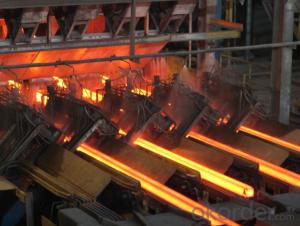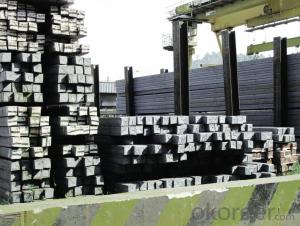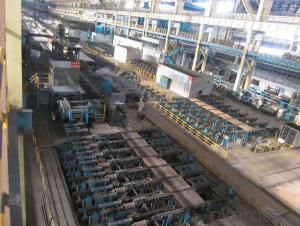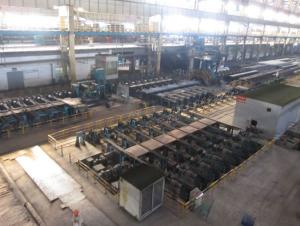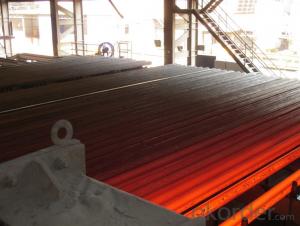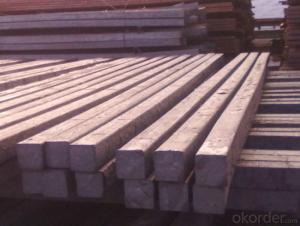Hot Rolled Square Steel Billet 3SP Standard 105mm
- Loading Port:
- Shanghai
- Payment Terms:
- TT OR LC
- Min Order Qty:
- 2000 m.t.
- Supply Capability:
- 10000 m.t./month
OKorder Service Pledge
OKorder Financial Service
You Might Also Like
Structure of Hot Rolled Square Steel Billet 3SP Standard 105mm

Description of Hot Rolled Square Steel Billet 3SP Standard 105mm
PPGI is made by cold rolled steel sheet and galvanized steel sheets as baseplate, through the surface pretreatment (degreasing, cleaning, chemical conversion processing), coated by the method of continuous coatings (roller coating method),
and after roasting and cooling. Zinc coating: Z60, Z80, Z100, Z120, Z180, Z275, G30, G60, G90
Alu-zinc coating: AZ60, AZ80, AZ100, AZ120, AZ180, G30, G60, G90
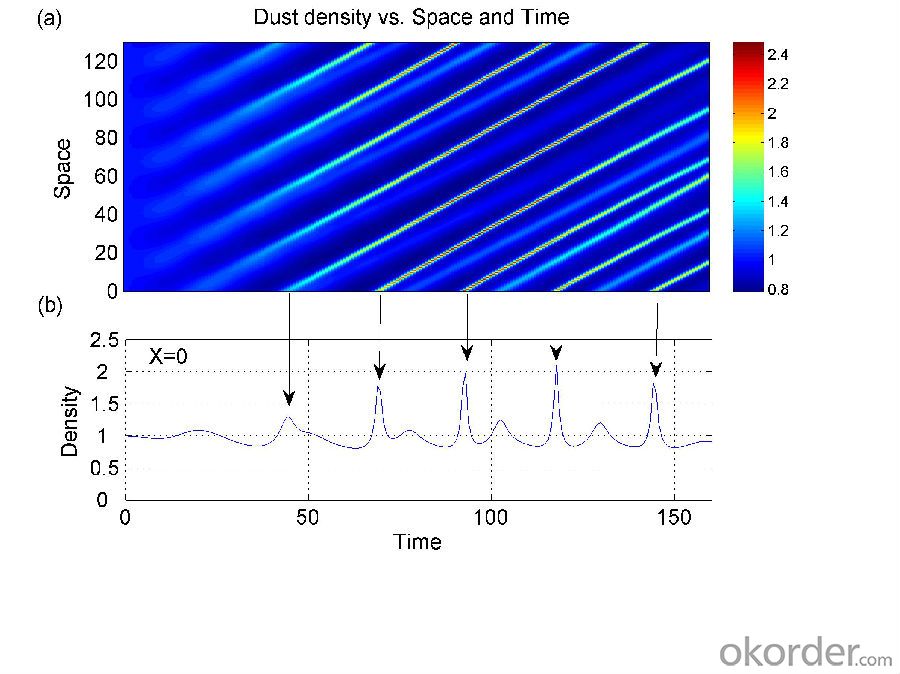
Main Feature of Hot Rolled Square Steel Billet 3SP Standard 105mm
1) Excellent corrosion resistance: The zinc layer provides a good protection of Pre-painted Galvanizeed Steel Sheet.
2) High heat resistance: The reflective surface of the material aids in efficiently reflecting the sunlight away and in turn reducing the amount of heat transmitted. The thermal reflectivity converts into energy savings.
3) Aesthetics: Pre-Painted Galvanized steel sheet is available in plethora of patterns and multiple sizes as per the requirements that given by our customers.
4) Versatility: can be used in the various areas.Standard seaworthy export packing: 3 layers of packing, inside is kraft paper, water plastic film is in the middle and outside GI steel sheet to be covered by steel strips with lock, with inner coil sleeve.
Applications of Hot Rolled Square Steel Billet 3SP Standard 105mm
1) Automotive bodies: filters, fuel tanks, etc.
2) Construction materials: roofings, welding pipes,
3) Electric and electronic appliances: computer cans, etc.
4) Steel cans: containers, etc.
5) Steel furniture: washing machines, refrigerators, microwaves, etc.
6) Drums
7) Office equipment: printer, recorders, etc.
8) Motors and transformers

Specifications of Hot Rolled Square Steel Billet 3SP Standard 105mm
| Classified symbol | Yield Point Minimum N/mm2 | Tensile Strength Minimum | Elongation Minimum % | Application | ||||
| N/mm2 | Nominal Thickness mm (t) | |||||||
| JIS | Yogic | 0.25-0.4 | 0.4-0.6 | 0.6-1.0 | 1.0-1.6 | |||
| G3312 | specification | |||||||
| CGCC | CGCC | -205 | -270 | -20 | -21 | -24 | -24 | Commercial |
| CGCD | CGCD | --- | 270 | --- | 27 | 31 | 32 | Drawing |
| --- | CG340 | 245 | 340 | 20 | 20 | 20 | 20 | Structural |
| CGC400 | CG400 | 295 | 400 | 16 | 17 | 18 | 18 | Structural |
| CGC440 | CG440 | 335 | 440 | 14 | 15 | 16 | 18 | Structural |
| CGC490 | CG490 | 365 | 490 | 12 | 13 | 14 | 16 | Structural |
| CGC570 | CG570 | 560 | 570 | --- | --- | --- | --- | Structural |
| ASTM Designation | Yield Point Minimum | Tensile Strength Minimum | Elongation Minimum % | Application | Q/BQB 445-2004(China standard) | ASM A653/A653M | JISG 3312 | |
| ksi(MPa) | ksi(MPa) | TDC51D+Z | (CS TYPE A+Z) | CGCC | ||||
| A653(M)-99 CS TYPE A,B,C | --- | --- | --- | Commercial | TDC52D+Z | CGCD | ||
| A653(M)-99 FS | --- | --- | --- | Lock Forming | TS250GD+Z | (G250+Z) | - | |
| A653(M)-99 DS | --- | --- | --- | Drawing | TS300GS+Z | (G300+Z) | CGC 400 | |
| A653(M)-99 SS Grade33(230) | 33(230) | 45(310) | 20 | Structural | TS350GD+Z | (G350+Z) | CGC490 | |
| A653(M)-99 SS Grade37(255) | 37(255) | 52(360) | 18 | Structural | TS550GD+Z | (G550+Z) | CGC570 | |
| A653(M)-99 SS Grade40(275) | 40(275) | 55(380) | 16 | Structural | ||||
| A653(M)-99 SS Grade50(345) | 50(345) | 65(450) | 12 | Structural | ||||
| A653(M)-99 SS Grade80(550) | 80(550) | 82(570) | --- | Structural | ||||
FAQ of Hot Rolled Square Steel Billet 3SP Standard 105mm
We have organized several common questions for our clients,may help you sincerely:
1. How Can I Visit There?
Our company is located in Tianjin City, China, near Beijing. You can fly to Tianjin Airport Directly. All our clients, from home or aboard, are warmly welcome to visit us!
2. How Can I Get Some Sample?
We are honored to offer you sample.
3. Why choose CNBM?
1, ISO, BV, CE, SGS approved.
2, Competitive price and quality.
3, Efficient service team online for 24 hours.
4, Smooth production ability(50000tons/month) .
5, quick delivery and standard exporting package.
6, Flexible payment with T/T, L/C, Paypal, Kunlun bank, etc .
- Q:What are the common applications of steel billets?
- Steel billets are semi-finished products that are used in various industrial applications. Some of the common applications of steel billets are: 1. Construction: Steel billets are widely used in the construction industry for structural purposes. They are used to manufacture beams, columns, and other load-bearing components in buildings, bridges, and other structures. The high strength and durability of steel billets make them ideal for withstanding heavy loads and providing structural integrity. 2. Automotive Industry: Steel billets are extensively used in the automotive industry for manufacturing various components such as crankshafts, camshafts, connecting rods, and gears. The excellent mechanical properties of steel billets ensure the reliability and performance of these critical automotive parts. 3. Machinery and Equipment Manufacturing: Steel billets are used in the production of machinery and equipment. They are utilized for manufacturing parts like gears, shafts, valves, and hydraulic cylinders. The versatility of steel billets allows for the customization of these components to meet specific operational requirements. 4. Electrical Industry: Steel billets find applications in the electrical industry for the production of electrical transformers and electric motor cores. The high magnetic permeability and electrical conductivity of steel make it an ideal material for these applications. 5. Pipe Manufacturing: Steel billets are commonly used in the manufacturing of pipes and tubes. They are processed through various techniques such as hot rolling, cold rolling, and extrusion to produce seamless or welded pipes. The strength and corrosion resistance of steel billets make them suitable for transporting fluids and gases in industries like oil and gas, water supply, and construction. 6. Shipbuilding: Steel billets are crucial in shipbuilding due to their strength, durability, and resistance to corrosion. They are used to manufacture various ship components such as hulls, frames, and bulkheads. The ability of steel billets to withstand harsh marine environments makes them an ideal choice for constructing ships and offshore structures. Overall, steel billets are versatile materials that find applications in a wide range of industries, thanks to their excellent mechanical properties, durability, and ability to be customized to meet specific requirements.
- Q:How are steel billets used in the manufacturing of food processing equipment?
- Steel billets are indispensable for the production of food processing equipment. These semi-finished steel products serve as the raw material for making various components and parts needed in the construction of food processing machinery. First and foremost, steel billets are utilized to construct the main structural frame of the equipment. The strength and durability of steel make it perfect for providing the necessary stability and support for the entire machinery. By cutting and shaping the billets to the desired dimensions, a solid framework is formed, ensuring that it can endure the demanding requirements of industrial food processing. Additionally, steel billets are also employed in the manufacturing of specific components within the equipment. For example, they are used to create cutting blades, grinding discs, and mixing paddles, which are vital in the food processing process. These components must be sturdy and resistant to wear and corrosion, and steel billets offer the ideal material to meet these requirements. Moreover, steel billets are often chosen for constructing food processing equipment that requires high levels of hygiene and cleanliness. Particularly, stainless steel billets are favored in such applications due to their inherent resistance to rust and corrosion. These billets are used to fabricate parts that come into direct contact with food, such as storage tanks, conveyors, and mixing chambers, ensuring that the food processing equipment is safe and hygienic. Furthermore, steel billets are employed in the manufacturing of heat exchangers and boilers used in food processing. These billets are designed to withstand high temperatures and pressure, making them suitable for applications that involve cooking, sterilization, or pasteurization of food products. To conclude, steel billets play a critical role in the production of food processing equipment. From providing structural support to fabricating specific components, they contribute to the creation of robust, efficient, and hygienic machinery that is essential for the food industry.
- Q:Are steel billets used in the production of sporting goods?
- Yes, steel billets are commonly used in the production of sporting goods. They are often utilized to create various components such as the shafts of golf clubs or the frames of bicycles. Steel billets provide durability and strength to these sporting goods, making them suitable for intense physical activity.
- Q:How do steel billets contribute to the manufacturing of aerospace components?
- The manufacturing of aerospace components heavily relies on steel billets, which are semi-finished products utilized as the initial material in creating various aerospace parts. The versatility of steel billets contributes significantly to the manufacturing of aerospace components. Steel possesses exceptional strength, durability, and corrosion resistance, making it an ideal material for aerospace applications. High-quality steel billets form a solid foundation for producing components that can withstand the extreme conditions encountered during aerospace operations. Steel billets find extensive use in manufacturing critical aerospace parts such as engine components, landing gear, structural frames, and fasteners. The billets undergo heating and are then subjected to various forming and machining processes. These processes, including forging, rolling, and extrusion, shape the steel billets into the desired components, ensuring they meet the aerospace industry's stringent requirements for strength, precision, and weight reduction. Additionally, steel billets offer remarkable design flexibility. They can be easily machined and shaped into intricate geometries, enabling manufacturers to create aerospace components with precise tolerances. This flexibility allows the production of lightweight yet sturdy parts, contributing to aircraft weight reduction and enhancing fuel efficiency. Moreover, steel billets possess superior metallurgical properties. By employing appropriate heat treatment and alloying techniques, the mechanical properties of the steel can be customized to meet specific aerospace requirements. This enables manufacturers to achieve the desired balance between strength, stiffness, and toughness in the final components, ensuring their ability to withstand the high-stress environments encountered in aerospace applications. In conclusion, steel billets play an indispensable role in the manufacturing process for aerospace components. Their versatility, strength, design flexibility, and metallurgical properties make them an excellent starting material for producing critical parts in the aerospace industry. Utilizing steel billets allows manufacturers to ensure the production of high-quality, reliable, and long-lasting components that meet the rigorous demands of the aerospace sector.
- Q:How are steel billets used in the production of agricultural equipment?
- Steel billets are an essential component in the production of agricultural equipment due to their versatility and durability. These billets are semi-finished steel products that are shaped into a solid rectangular form, making them ideal for various manufacturing processes. In the production of agricultural equipment, steel billets are typically used as the raw material for forging, casting, or rolling processes. Forging involves heating the billets to a specific temperature and then shaping them into the desired form using a hammer or press. This process is commonly used to create components such as plowshares, tiller blades, and harrow teeth, which require superior strength and resistance to wear and tear. Casting is another method used in agricultural equipment production, where molten steel is poured into a mold and left to solidify. Steel billets are melted and cast into intricate shapes, allowing manufacturers to create complex components like tractor engine blocks, combine harvester parts, or even agricultural machinery frames. The ability to cast steel billets into various shapes enables the production of customized equipment that meets specific requirements. Rolling is another technique that utilizes steel billets in the production of agricultural equipment. These billets are heated and then passed through a series of rollers to reduce their size and shape them into different profiles, such as bars, rods, or sheets. Rolled steel billets are commonly used in the manufacturing of components like axles, shafts, and brackets, which are crucial for the functionality of agricultural machinery. One of the key reasons steel billets are preferred in agricultural equipment production is their inherent strength and durability. The agricultural industry demands robust machinery that can withstand harsh environments, heavy loads, and repetitive use. Steel billets offer exceptional strength, allowing manufacturers to create equipment that can endure these demanding conditions. Additionally, steel billets can be further strengthened through heat treatment processes, such as quenching and tempering, to enhance their mechanical properties. In conclusion, steel billets play a vital role in the production of agricultural equipment. Their versatility and durability enable manufacturers to create components and machinery that can withstand the challenging conditions of the agricultural industry. Whether used in forging, casting, or rolling processes, steel billets provide the necessary strength and reliability required for efficient and long-lasting agricultural equipment.
- Q:How do steel billets come out?
- Three, steel rolling:Rolling steel or continuous casting billet into various steels by rolling mill
- Q:Can steel billets be used in the production of sculptures and artwork?
- Sculptures and artwork can indeed utilize steel billets. Steel, being a versatile and malleable material, empowers artists to fashion one-of-a-kind and intricate designs. The inclusion of steel billets in sculptures and artwork guarantees sturdiness, resilience, and the potential for expansive installations. Artists can skillfully mold, fuse, and manipulate steel billets to generate an extensive array of sculptures, ranging from abstract shapes to figurative representations. The utilization of steel also contributes a contemporary and audacious touch to the artwork, thanks to its industrial aesthetic. Moreover, artists can opt to employ diverse techniques such as painting, patina, or polishing to further enrich their creative vision. In summary, steel billets present an exhilarating prospect for artists to delve into and stretch the boundaries of their artistic expression.
- Q:How are steel billets used in the manufacturing of electrical transmission equipment?
- Steel billets serve as a key raw material in the manufacturing of electrical transmission equipment. They are solid blocks of steel that undergo further processing to create various components necessary for electrical transmission equipment. One crucial application of steel billets in this field is for the production of transmission towers. These towers are essential infrastructure that supports power lines and facilitates the secure and efficient transmission of electricity over long distances. Steel billets are utilized in the manufacturing of the structural elements of these towers, including the main vertical and horizontal members, as well as the cross arms and braces. Moreover, steel billets are also employed in the production of conductors for electrical transmission equipment. Conductors are the cables responsible for carrying electrical current between power generation stations and distribution networks. Steel billets are processed to create the wires and strands required to construct these conductors. The remarkable strength and durability of steel make it an excellent material choice for these applications, as it can withstand the high tension and load demands of electrical transmission systems. Furthermore, steel billets are utilized in the manufacturing of various other components used in electrical transmission equipment, such as pole line hardware, insulators, and connectors. These components are essential for the proper functioning and reliability of the electrical transmission system, and steel billets provide the necessary strength and stability required for their construction. To summarize, steel billets play a crucial role in the manufacturing of electrical transmission equipment. They are used to produce transmission towers, conductors, and other vital components, ensuring the safe and efficient transmission of electricity over long distances.
- Q:What shape is the billet?
- Mainly from the shape of two:Slab: the ratio of section width and height is larger, which is mainly used for rolling plate.Billet: cross section width, height equal, or difference is not big, mainly used for rolling steel, wire.Texture of materialContinuous casting square and rectangular billets are mainly made of plain carbon steel, low carbon and low silicon cold rolled material, high quality carbon structural steel, low alloy high strength steel, special steel and so on.
- Q:What are the different types of steel billet heat treatment processes?
- There are several types of steel billet heat treatment processes that are commonly used in the industry. These processes aim to improve the mechanical properties of the steel billets, such as strength, hardness, toughness, and ductility, to meet specific application requirements. Some of the different types of steel billet heat treatment processes include: 1. Annealing: This process involves heating the steel billet to a specific temperature and then slowly cooling it to room temperature. Annealing helps to relieve internal stresses and improve the machinability and ductility of the steel. 2. Normalizing: In this process, the steel billet is heated to a temperature above its critical point and then allowed to cool in still air. Normalizing refines the grain structure of the steel, resulting in improved mechanical properties and uniformity. 3. Quenching: Quenching involves rapidly cooling the steel billet from a high temperature by immersing it in a quenching medium, such as water, oil, or polymer. This process creates a hardened structure in the steel, increasing its hardness and strength. 4. Tempering: After quenching, the steel billet is heated to a lower temperature and then cooled slowly. Tempering reduces the brittleness caused by quenching and improves the toughness, ductility, and machinability of the steel. 5. Austempering: This process involves quenching the steel billet to a temperature just above the martensite transformation range and holding it at that temperature until it transforms to bainite. Austempering results in a structure with improved strength, toughness, and wear resistance. 6. Martempering: Martempering is similar to austempering, but the steel billet is quenched into a medium at a temperature slightly above the martensite transformation range and then held until it cools to below that temperature. This process produces a structure with improved toughness and reduced distortion compared to conventional quenching. These are just a few of the many heat treatment processes used for steel billets. The choice of process depends on the desired mechanical properties and application requirements of the steel.
1. Manufacturer Overview |
|
|---|---|
| Location | |
| Year Established | |
| Annual Output Value | |
| Main Markets | |
| Company Certifications | |
2. Manufacturer Certificates |
|
|---|---|
| a) Certification Name | |
| Range | |
| Reference | |
| Validity Period | |
3. Manufacturer Capability |
|
|---|---|
| a)Trade Capacity | |
| Nearest Port | |
| Export Percentage | |
| No.of Employees in Trade Department | |
| Language Spoken: | |
| b)Factory Information | |
| Factory Size: | |
| No. of Production Lines | |
| Contract Manufacturing | |
| Product Price Range | |
Send your message to us
Hot Rolled Square Steel Billet 3SP Standard 105mm
- Loading Port:
- Shanghai
- Payment Terms:
- TT OR LC
- Min Order Qty:
- 2000 m.t.
- Supply Capability:
- 10000 m.t./month
OKorder Service Pledge
OKorder Financial Service
Similar products
New products
Hot products
Related keywords
